Euphoria started a few days before our trip, just as usual. We were to fly on Thursday, and I woke up at 5 AM on Monday morning. 😀 That was a good sign, my soul was ready to go.
We found quite a good connection, through Frankfurt, with Lufthansa and ANA line.
We needed some negotiation on both Dublin and Frankfurt airport, as we got seats on two different parts of the airplane, but luckily that was resolved nicely. 🙂
Cultural “shock” starts here, in Germany. All airplane staff bows when arriving to the counter, they turn and bow to their passengers. Then they bow to the plane. They bow before departure, before landing, once landed, and when you are leaving the plane. It was interesting to watch the passengers too, as some of them knew each other. They bow when they see and recognize each other, and when they are separating and going to sit on a different parts of the airport gate. 🙂 And we did not even start yet… 🙂
As soon as we took off I started reading in-flight magazine and noticed that Japanese fleet is the strongest fleet on this planet. 🙂 If I only knew that information earlier, I’d book a flight with Millennium Falcon. Maybe next time. 🙂
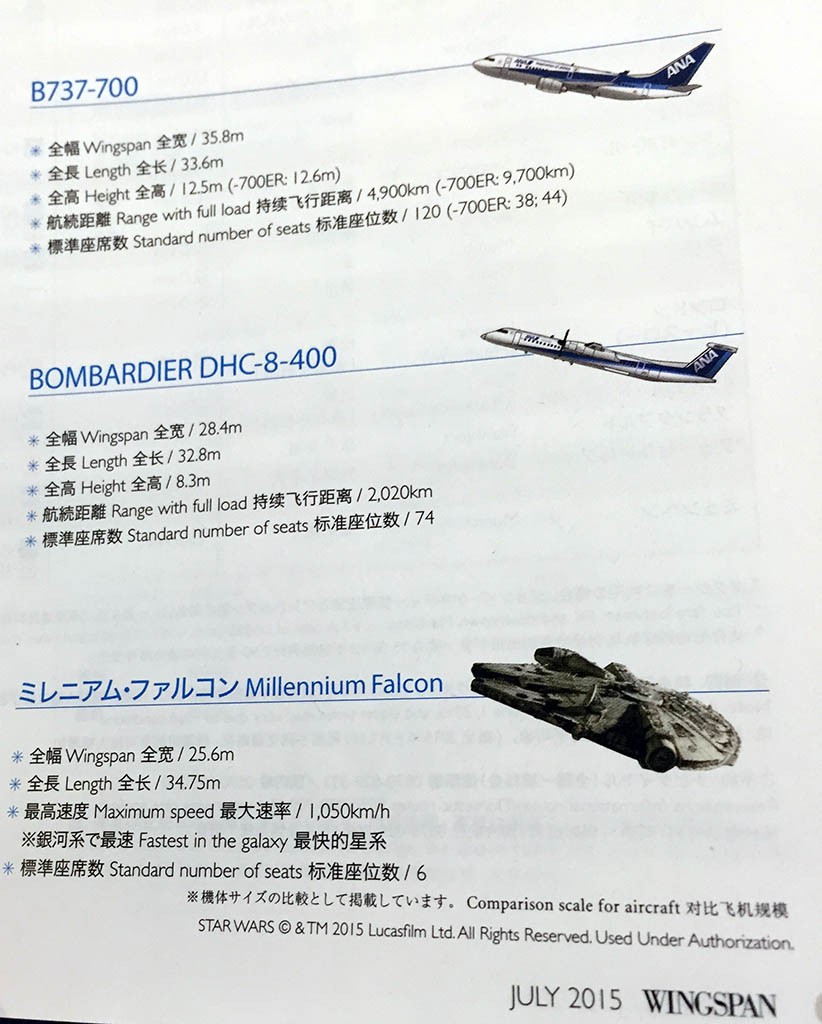
Flight was calm, without any turbulences, and the fact that there were three or four little babies around us did not change a thing. Not a single one cried or yelled. We were later surprised by calm kids throughout the whole journey as we saw only one Japanese kid crying in one of the trains, but in general they are all nice and quiet. 🙂
There were two meal options, Western food and Japanese one for every meal on ANA flights. We both opted for a Japanese dinner, and fish curry was quite nice. Of course, I started with Asahi beer somewhere in the air. 🙂
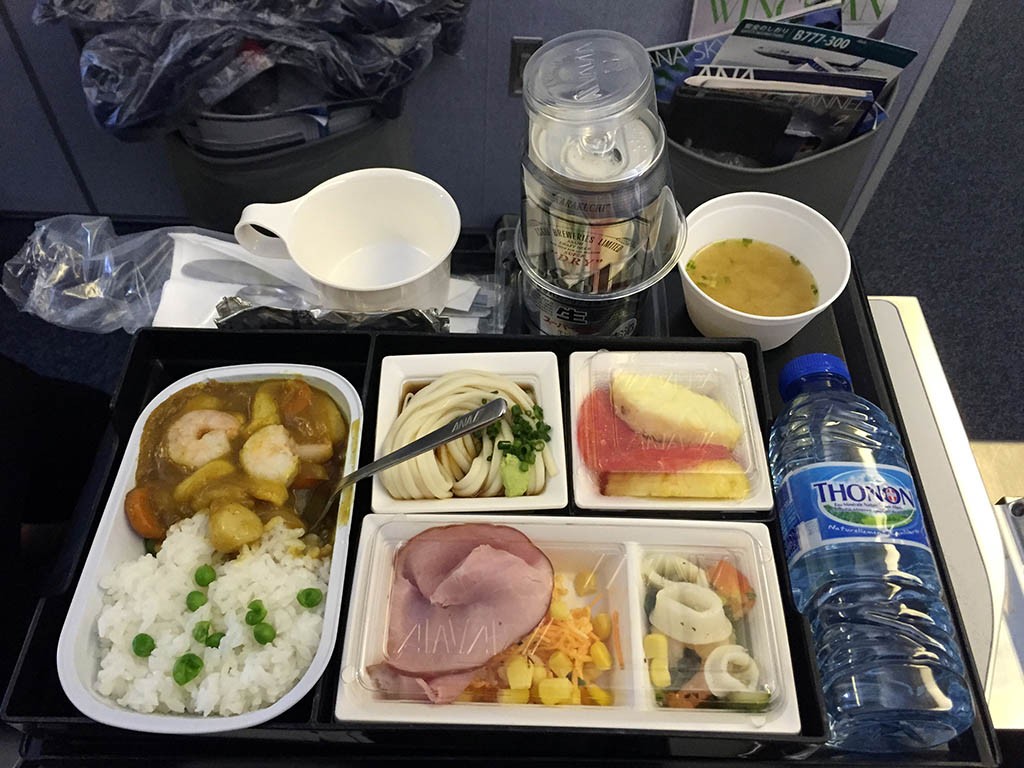
Since we could not sleep for some strange reason, we had 11 hours to kill. Dina decided to watch Chappie, I was reading a book for a few hours then decided to watch a Japanese comedy about an old lady that gets young and back in her best age (around 30) and she is reliving what she missed as a young girl. It is all but a comedy, since I had to stop watching 15 minutes before the end of the movie. It is a heavy drama with traces of comedy. Very emotional movie, highly recommended for everyone. The story intertwines Japanese traditional values, showing the bond between parents and children, as well as changes that are visible in Japan today, and how Japan “westernises” too. I wanted to see the end of the movie on the way back, but was not available any more.
Dina did not like the breakfast description and she opted for a western breakfast, while I decided to try “rice porridge mixed with eggs”.
What I expected was sweet rice pudding, and what I got was savoury rice with eggs, mussels and beans. Not really “breakfast” kind of meal, besides, no one mentioned it will smell and taste fishy. 🙂
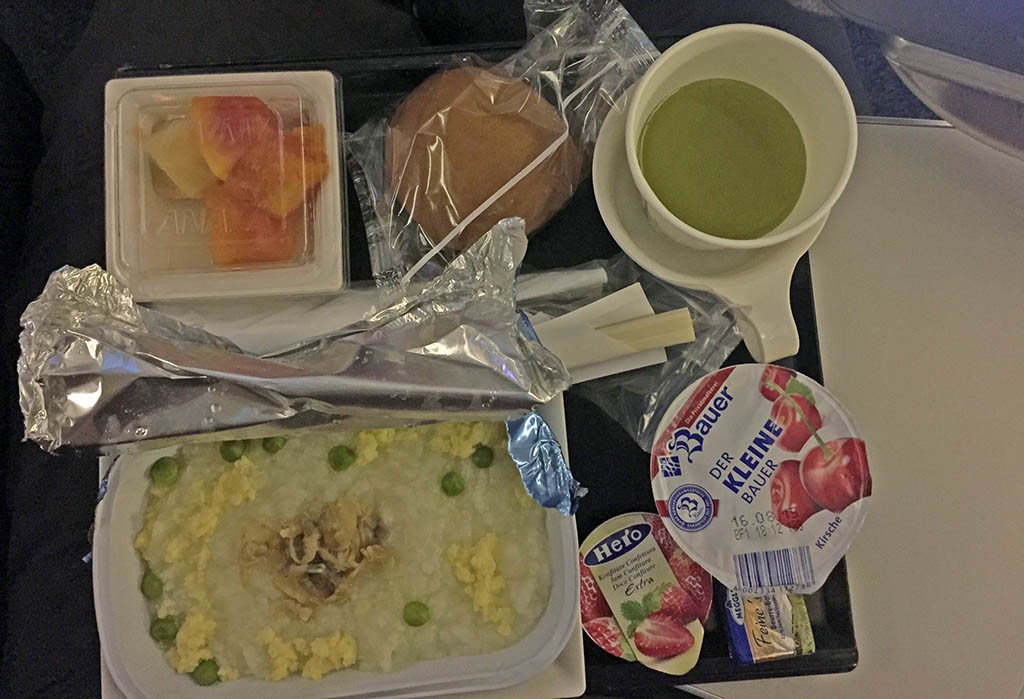
And then we arrived to that big and different world.
Haneda airport, Tokyo, Japan.
Welcoming airport staff, organized police and customs and within 30 minutes we were officially in Japan. It took us around 10 minutes to figure out that this country is a bit different. People are all incredibly polite. When you ask for help, they will always do it with a big smile. So they explained us that the JR office, where we need to exchange our JR vouchers for JR passes, opens at 7:45, and that we have to wait for almost an hour. We decided to use that time to grab a coffee and some quick snack.
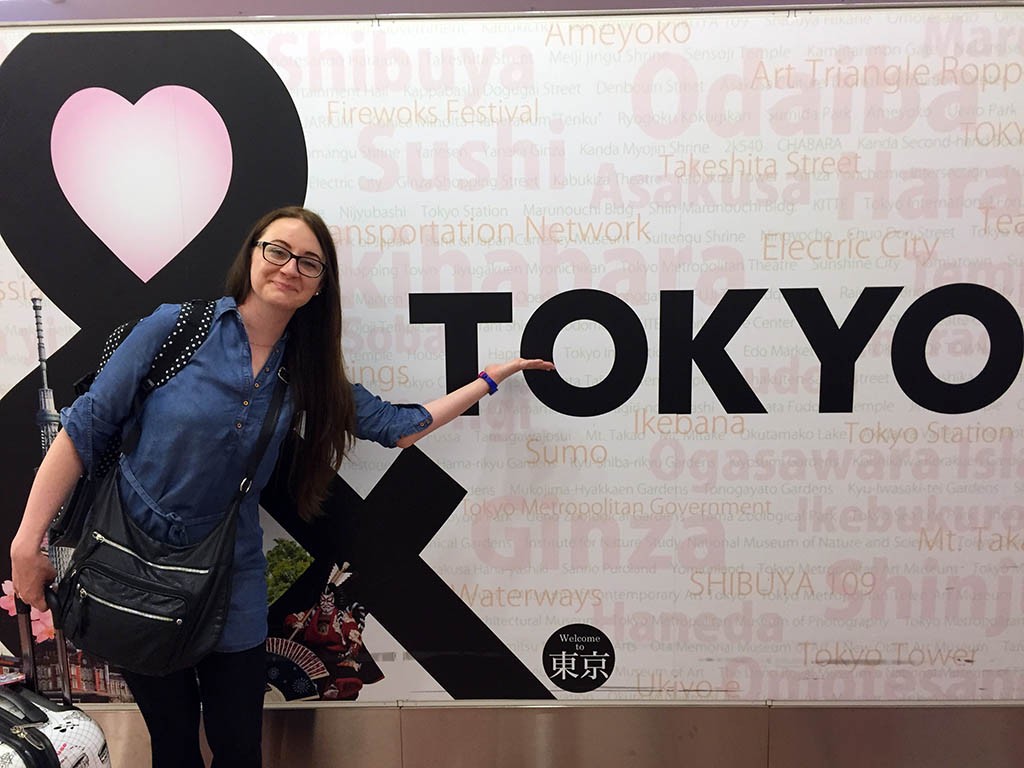
It was quite hot on the airport itself, around 28 degrees at 6:30 AM, so we decided to go for a coffee, iced green tea and two “triangles made of rice with salmon and plum” – or as they are called in Japan – Onigiri. Again, we expected one with plum to be sweet rice desert, but once again, we are getting confused. It was a salty, very salty meal that tastes like salty plum marmalade. Kinda nice to tell you the truth, but weird. Ice tea was exactly what the word says – Iced tea. And yes, that means that there is no additional sugar in it. So if you expect European or American super sweet “tea” you’ll be surprised. 🙂 Even though we both like sweets, we don’t like sugar in absolutely everything, and tea is one thing that does not require sugar at all. 🙂
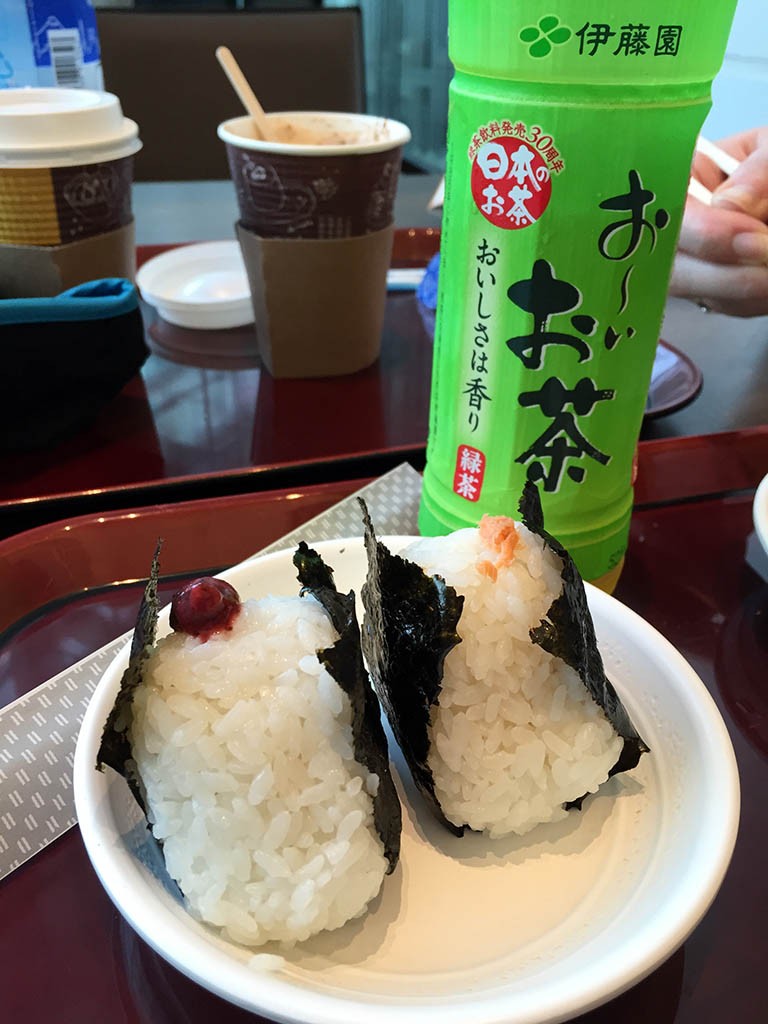
The temperature rose a bit, and while I was in line for JR passes Dina had to change, as Irish layered dress up does not fit well in Tokyo. 🙂
I stubbornly refused to change till we reach the apartment. A bit of acclimatization, in a way. It will anyway be above 33 for the whole 2 weeks while we are here. 🙂
We picked the passes, SUICA cards and directions to our apartment, and headed there. It took us about 55 minutes with a direct line from Haneda Airport to Katsushika-Tateishi.
It really didn’t take much to notice majority of things we consider typical for Japan, or we stereotype as Japanese. In first hour we got exposed to the fact that rice is eaten with every meal including snacks to go, that Japanese are extremely polite and willing to help, that airport, train station and trains are so clean that you just can’t believe it, and on one of first stops older lady in kimono got in the train. 🙂
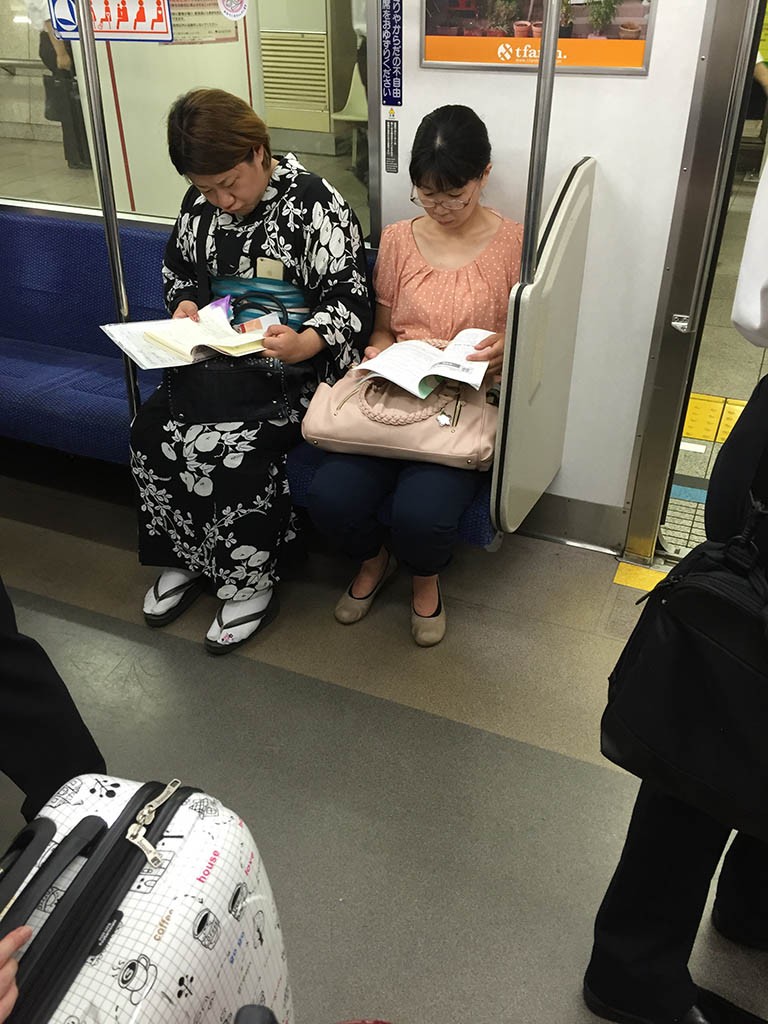
From the main Tateishi station it took us just a few minutes to our apartment.
On the way to the apartment we’ve noticed that another “typical” thing for Japan. Vending machines. It seems that there’s one in every street, private yards, beaches… 🙂

In front of the apartment we’ve met our host, left our luggage, picked up the portable MiWi internet, and headed straight back to city exploration. Yep, we’ve decided to suppress the Jet Lag by not sleeping that day even though it was midnight in Europe. 🙂
SkyTree in Sumida, Oshiage-Sumida
Just to clarify things, Tokyo is organized like a bunch of small towns, now districts or wards all connected into Tokyo City, metropolitan area where around 35 million people live. Each district you visit in Tokyo is like visiting a different town, except it’s all called Tokyo.
Our first stop – Tokyo Skytree tower, located in Sumida district.
It is the second highest building on this planet at the moment with it’s 634 meters. Later, I’ve found out that area where the tower is built is called “Musashi” and it is actually – Mu = 6, Sa = 3 and Shi = 4. So, in order to make it simple to remember, Japanese built a tower with height equal to the area name. 🙂

The whole area is new, modern, built just a few years back (2012) and there are two available floors for visitors. Regular, on height of 350 meters, and additional one at 450 meters. When we got there, waiting time to take us to the first floor was about one hour and thirty minutes. We almost decided not to go up, but then a member of the staff explained us that there is an “express” line, which is just a few Euros more.
Within 3 minutes we were on the “first floor” with magnificent view over Tokyo city. Well, the view is better in different time of the year when humidity is lower than 80%, but it was still good enough and worth seeing.
We took the additional tickets to the top deck, and we really enjoyed the view over Tokyo from 450 meters above. Impressive.
Since we got quite hungry, we decided to extend our stay and enjoy the view even more, as we’ve set in fancy “Musashi 634” restaurant.
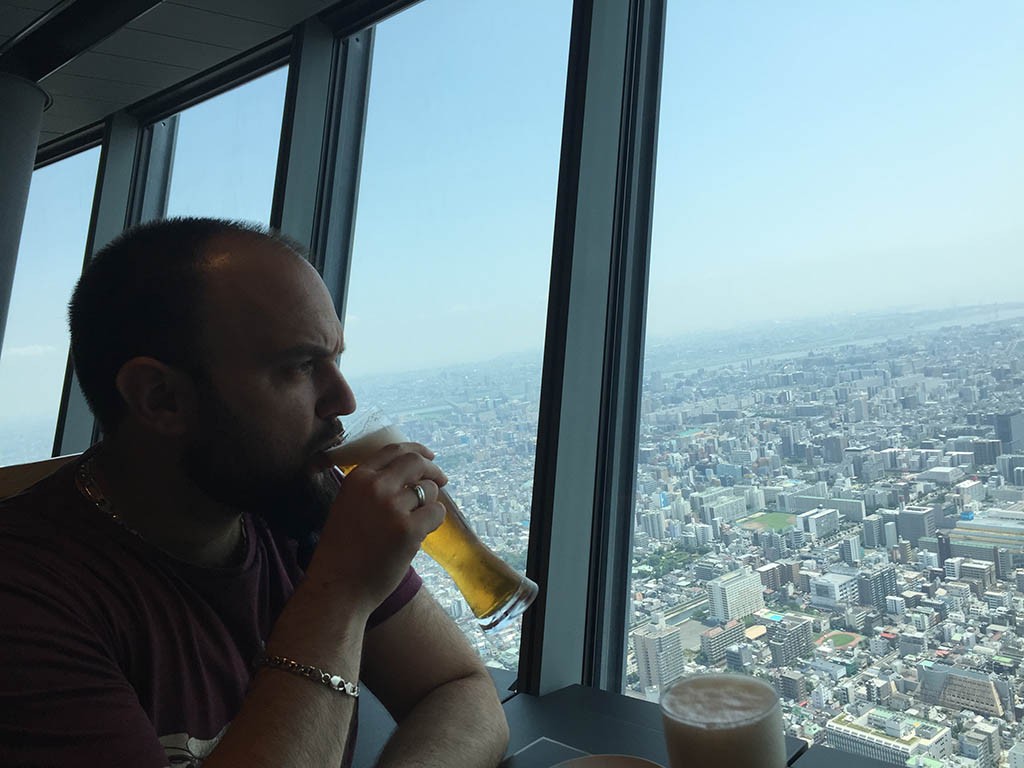
Lunch was extremely nice, and even though we expected it to be very pricey it was not. We had three course meal and a pint of beer on the “top of the world”.
Starters were weirdly cool. We first had some weird soup served in a small glass, with smoked squid and vegetables tasting quite smokey. Then we had three light bite starters, tuna, sea urchin and some other fish sashimi, foie gras with some balsamic glaze on top and silver like pearls, and a shrimp in onion and salsa rose dip.
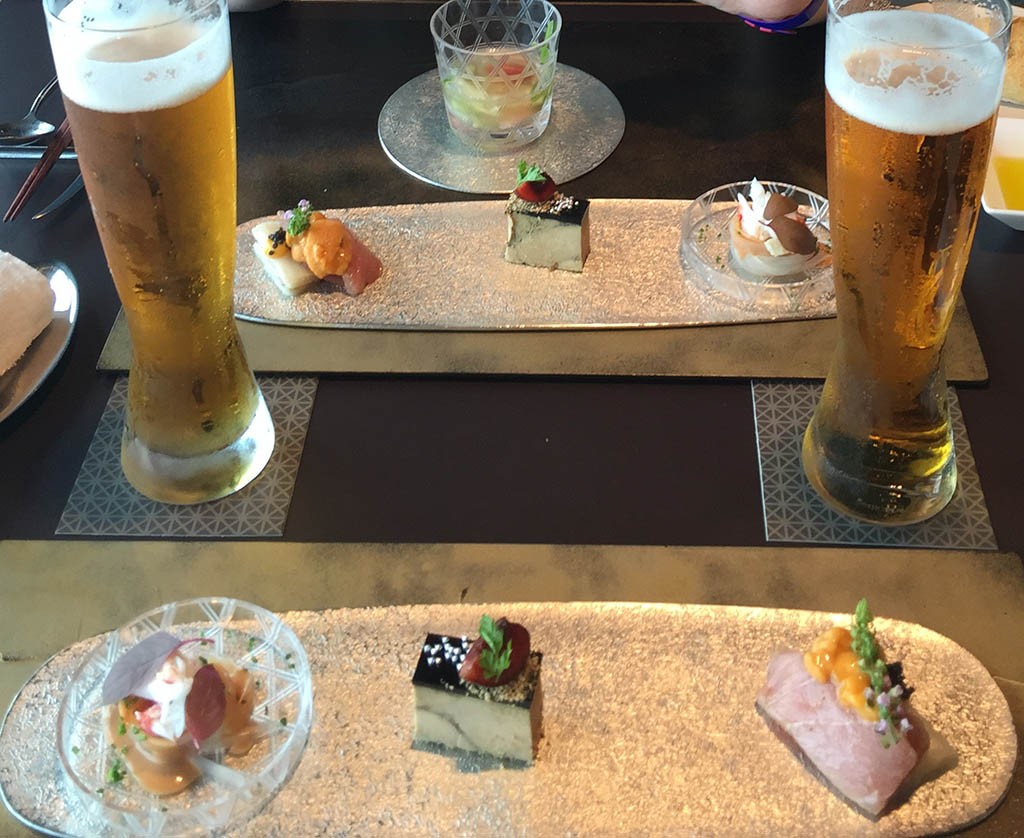
Main courses were also cool, Dina had sea bass fillet on the champagne foam and covered with herbs, while I opted for guinea fowl with fancy vegetables in saffron sauce.
We took lighter desserts, so I got a fancy fruit salad in cream and golden leaf on top. 🙂
And just to stay a couple more minutes longer I had a coffee too. 🙂
All that? Well, let’s say that such menu in a similar place in Dublin (not the view, but place with similar kind of service) cost us more here in Dublin.
Asakusa
We walked a while around Sumida area and then took a metro to Asakusa. Asakusa is a district in Tokyo known as the oldest Geisha district, oldest entertainment district, and area where the most important and well known Buddhist temple is located – Senso Ji temple.
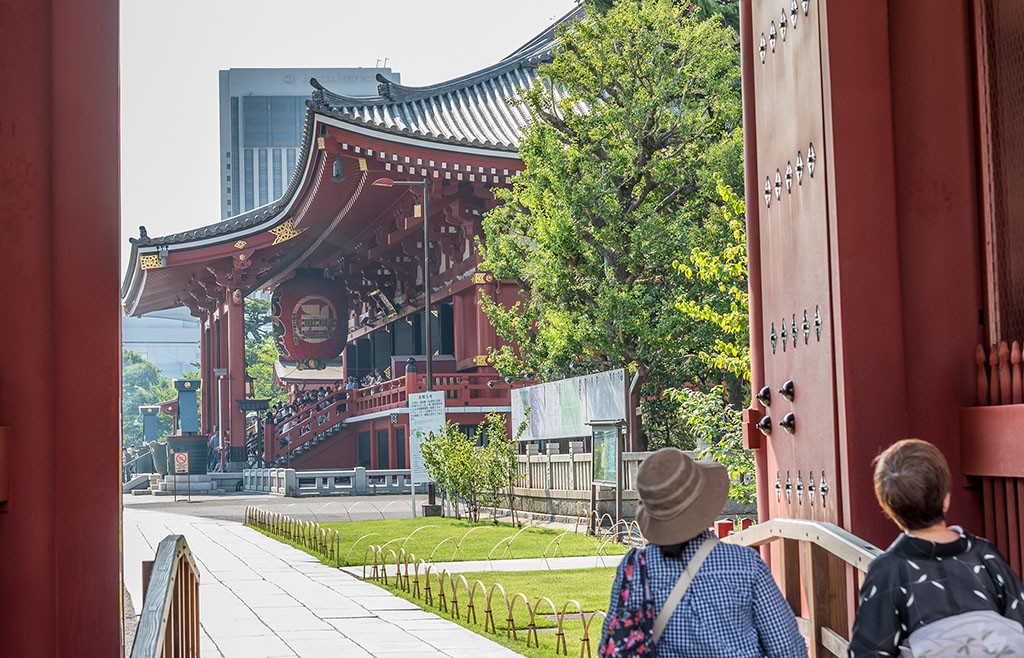
The original temple that was built in 645 CE was ruined during WW2 bombings, but was rebuilt as a symbol of re-birth and peace.

We explored Asakusa area for a while and then, even exhausted and dead tired with almost 48 hours without sleep, we decided to go and see something else since it’s just 6:00PM.
Shibamata
We checked the map where Shibamata was printed in red. (Tokyo map has red labels for important touristy districts) Well, why not, let’s head to Shibamata.
Even though Tokyo is well connected, getting to Shibamata took some time, besides we managed to exit on a wrong station and in the end we arrived there too late. Majority of places were closed including Taishakuten Temple. We only managed to see the yard in front.
Since it was getting dark and there was not much to do here, we decided to sit here in a typical Japanese restaurant and have a dinner. That area is known for fish restaurants so we decided to have some Unagi (Eel). Actually, I had a soup made of eel liver and a dish with loaches. I was not really sure what loach is but I just figured out next morning that I ate a pond fish. 🙂 It’s kinda similar to a baby eel, so it was not bad at all.
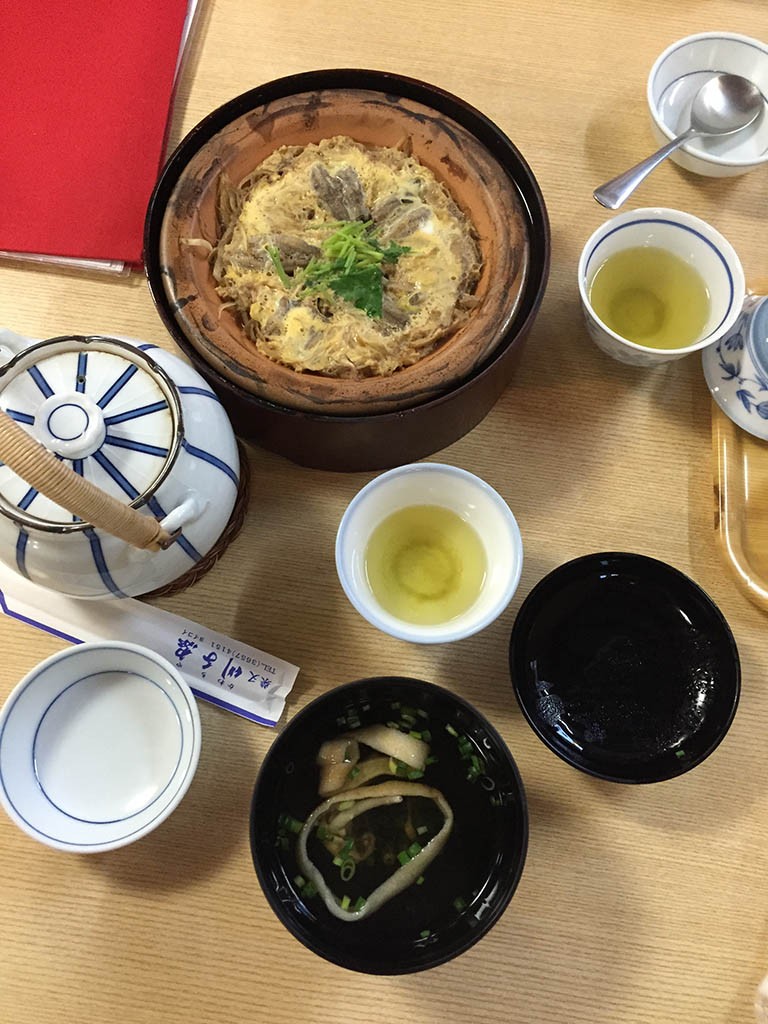
Tsukiji Market
After a good long sleep that night we headed towards Tsukiji where we planned to eat our first sushi on the well known Tsukiji fish market.
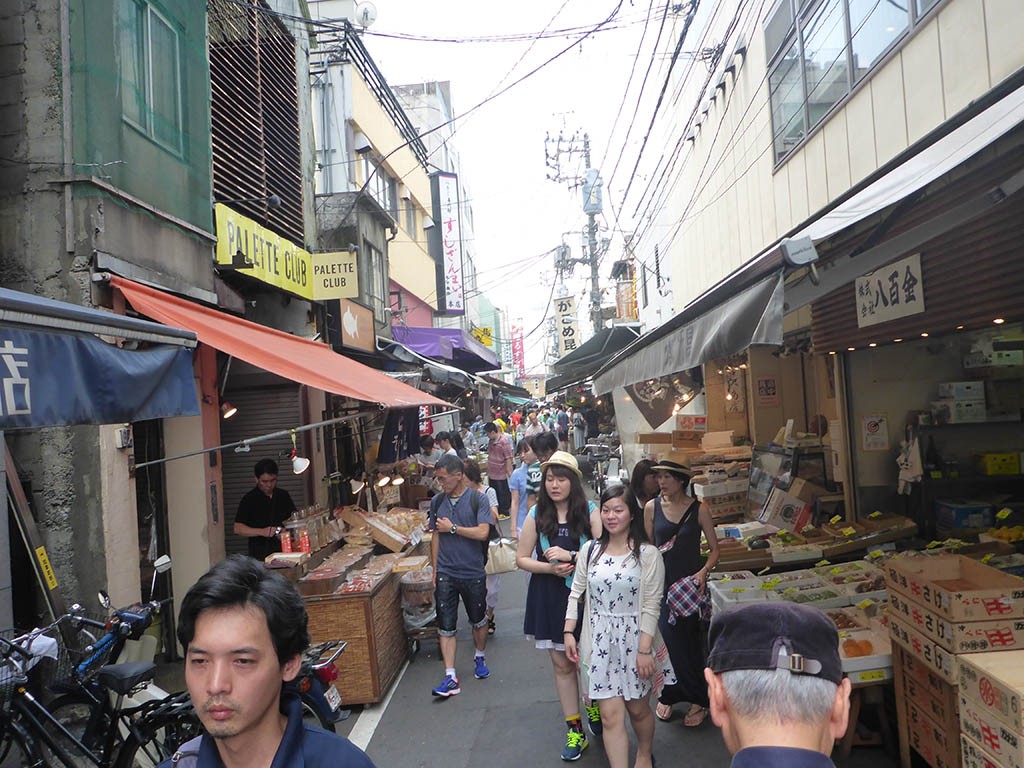
It’s Japanese most well known market and world’s largest whole sale fish market. The whole area is surrounded with small streets in which people can buy different fish products and fish related products. Such as wasabi grinder that is made of shark’s skin, or very sharp knifes to slice sashimi. And if you are coming from Europe it is quite an interesting place to be.
Snacks made of algae, dried squids and octopodes, shrimps in all sizes starting as micro to those macro ones.
We skipped a couple of places in order to find sushi and then we stopped to check the menu on one of the barracks there. An old lady speaking only Japanese invited us in. Dina asked for sushi and response was “no” sushi only sashimi. Dina said “Ah, no I want sushi” and old lady quickly explained here that she will get a bowl of rice, fresh fish and if she really wants it in sushi form she can use two fingers and create sushi on her own. 🙂
Well, we could not say no to such invitation. 🙂
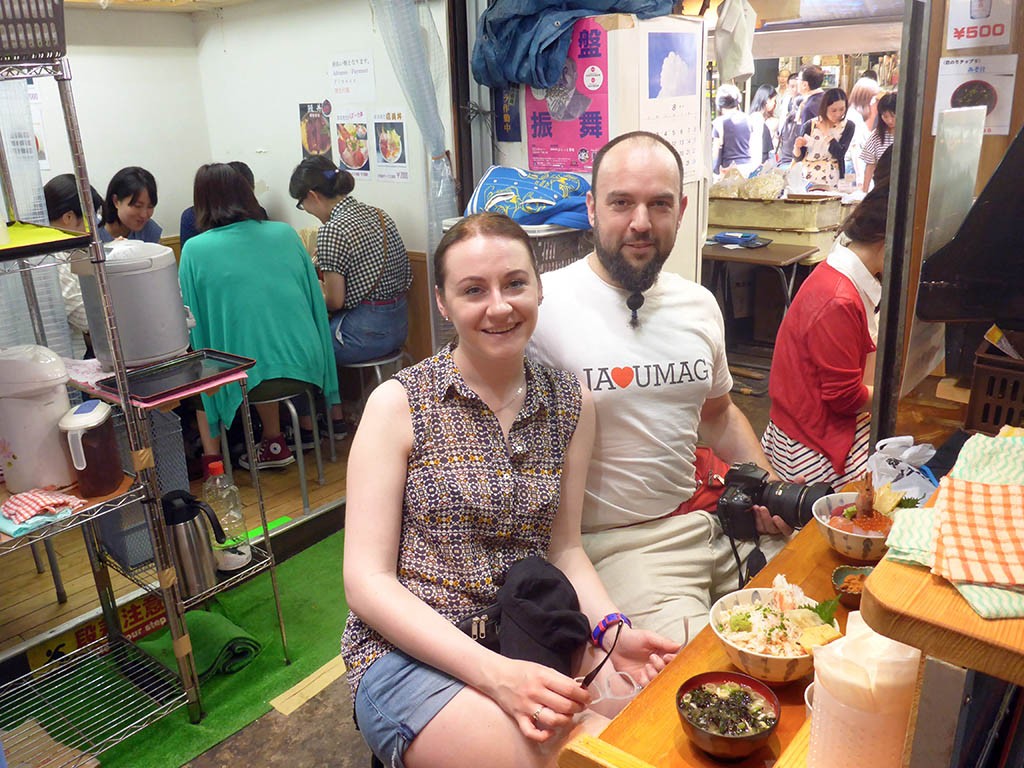
After we had some crab, fresh tuna, salmon, shrimps and sea urchin we walked around the area for a while and then headed towards Shibuya.
Shibuya
Shibuya is known for it’s Meiji Shrine, shopping area and world’s famous crossing – Shibuya scrambled crossing. It’s just in front of Shibuya station and it stops the traffic from all directions and allows pedestrians to go into any direction. Approximately 2500 people are crossing it every time green lights turn on. 🙂
And this is how it looked like just a few seconds before we crossed it:
Meiji Jingu Shrine
From Shibuya station we walked through the district and towards the Meiji Jingu Shrine.
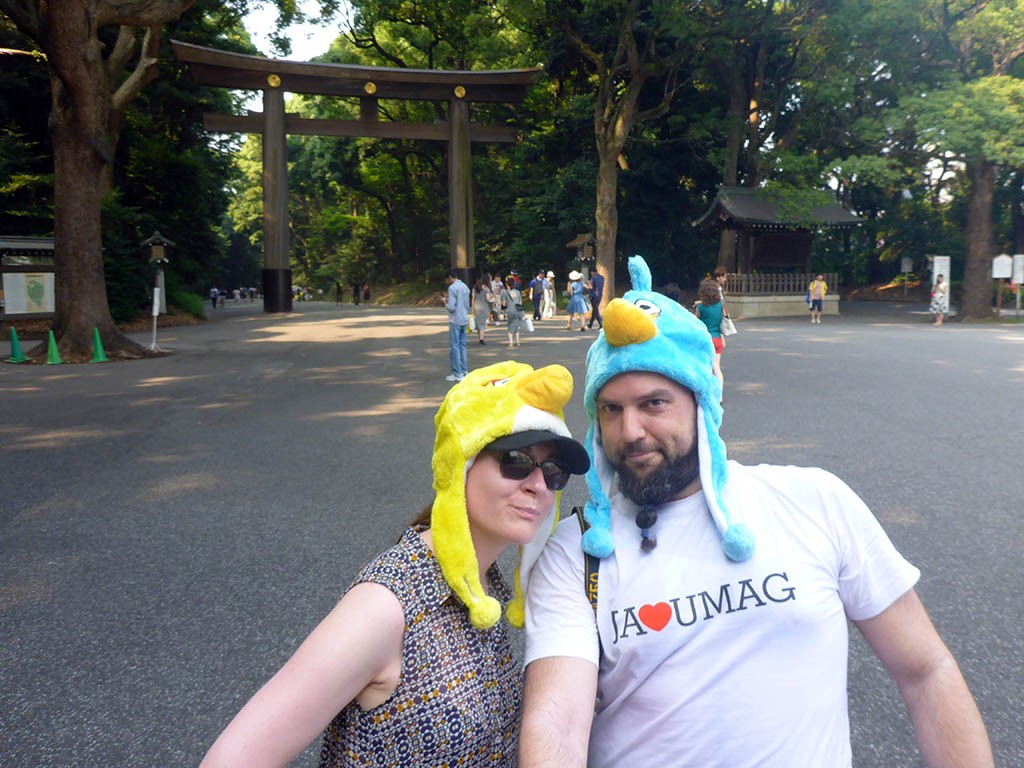
Meiji Shrine is the Shinto shrine located in a large park and it’s dedicated to the defied spirits of Emperor Meiji the Great, who died in 1912.
We took the opportunity to take our traditional birds photo here, but since it was around 39 degrees with real feel 42 (Celsius) we decided to take a rest first in the restaurant that is located within the Shrine gardens.
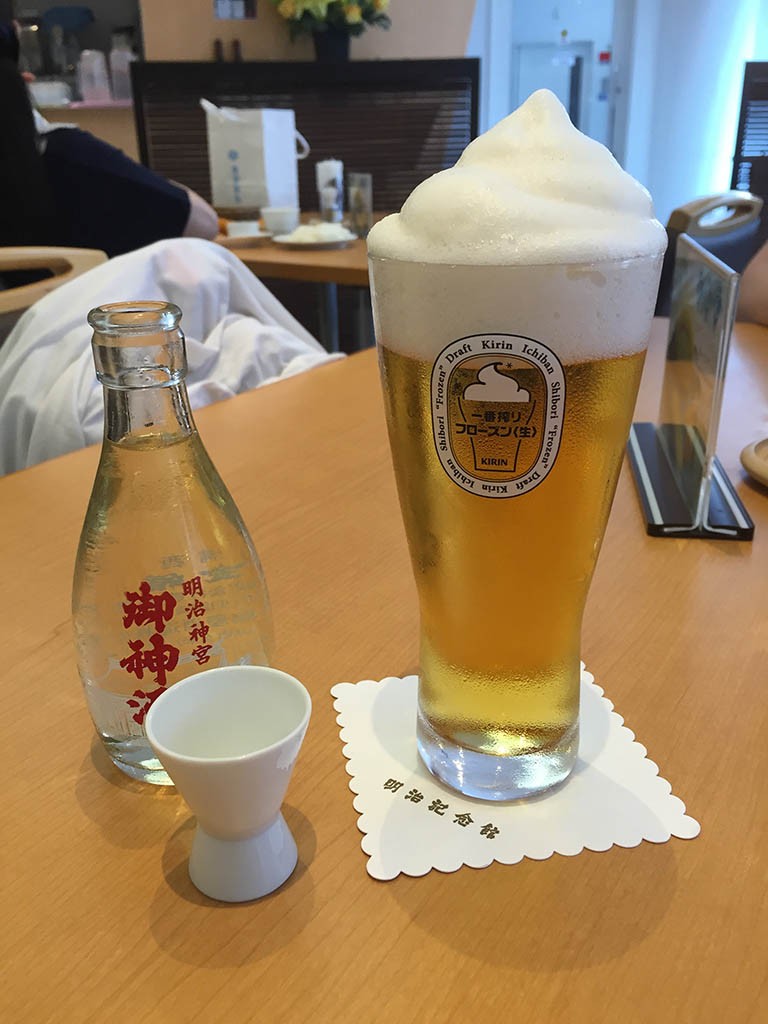
With lunch, we ordered Sake and frozen beer. Somehow they freeze beer foam and it is like softer crushed ice that tastes like beer and it does not dilute your beer at all. Cool thing for hot summer days as it keeps the beer fresh for a longer period of time. We learned here that Sake is always (at least in Japan) served as 1.8 dcl per person. That’s the amount you’ll get, not one small shot.
We walked around the temple area for a while and then we walked through Harajuku.
Harajuku
Harajuku is another famous place in Tokyo. It’s a part of Shibuya and it’s well known as Japanese youth fashion and culture centre. It’s an area where you expect to see the most weirdly dressed people in the world. But we were not really lucky. Out of this huge amount of people there were only two girls dressed differently and a bunch of regular people. Not sure if the reason is a great heat or the fact that there was a big fireworks festival in the other part of Tokyo.
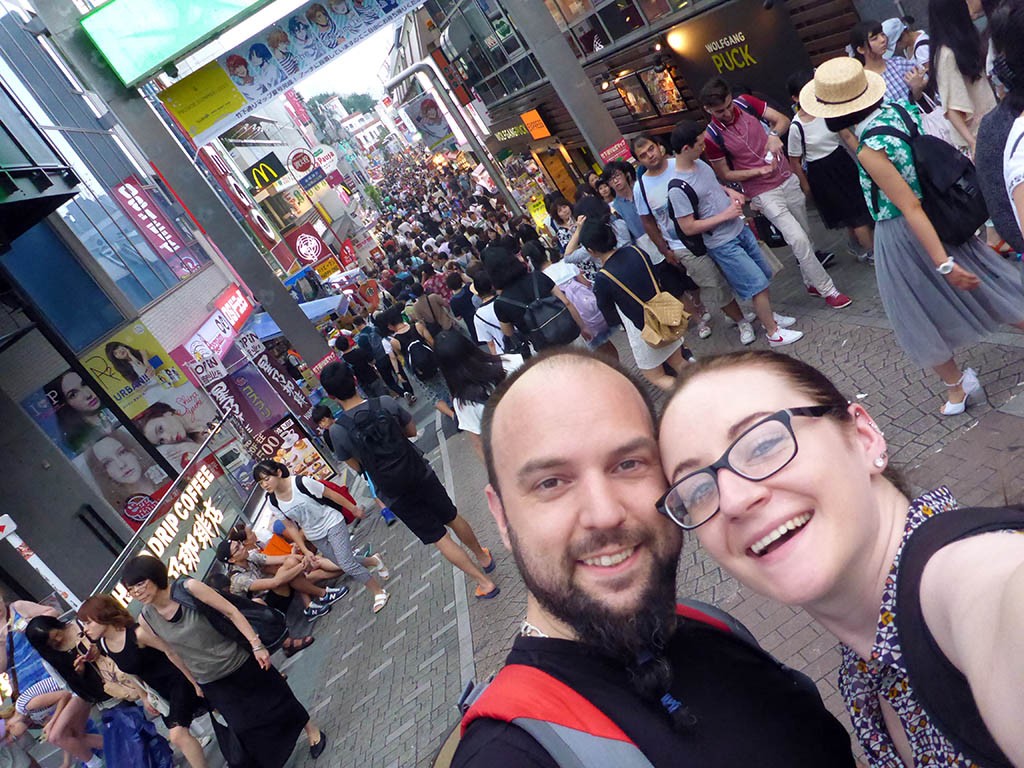
From Harajuku we walked towards Shinjuku where we booked a place in a famous Robot restaurant.
Shinjuku – Neon lights and Robot Show
Shinjuku is the major commercial and administrative district in Tokyo, with the busiest train station in the world.
A bunch of modern buildings, neon lights and crazy places can be found here. Craziest of them all – The Robot restaurant.
It’s a show that is not always the same, but there is one constant with it. It makes no sense whatsoever.
Our show started at the second floor where two guys dressed weirdly played trumpet and the electric guitar while lady a sang on a piano. It was far from professional performance but OK.
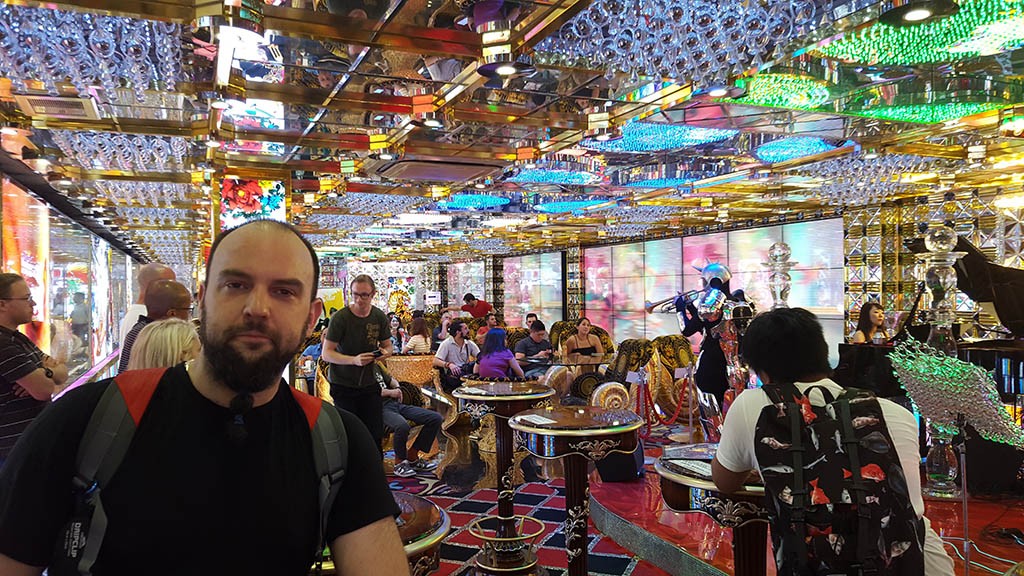
Then we moved to the basement where we watched a mixed combination of performances between opposed teams. So ladies performing on Japanese drums vs. beasts on the other side of the room. Ladies dancing traditional dances vs ladies screaming some weird noises.
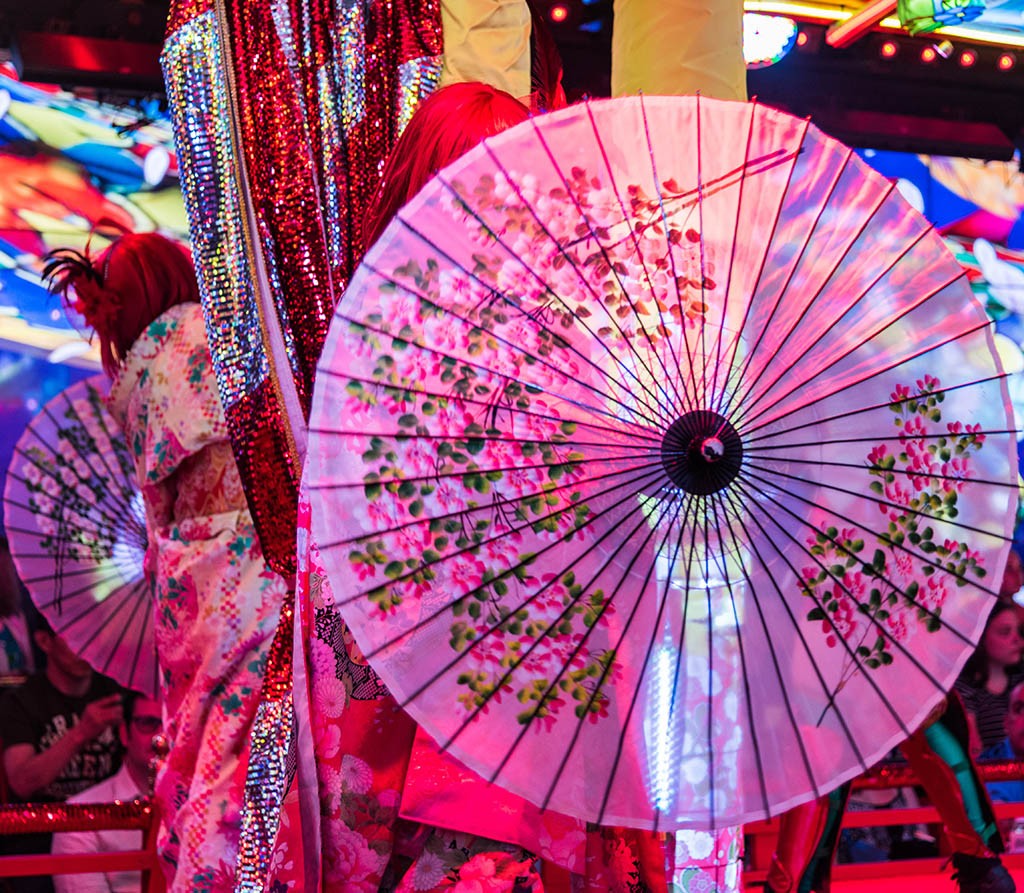
All the way to weird animals fighting robots. So at one point a big kung fu panda riding a cow is fighting with robots. Panda dies, robots are stronger. :))
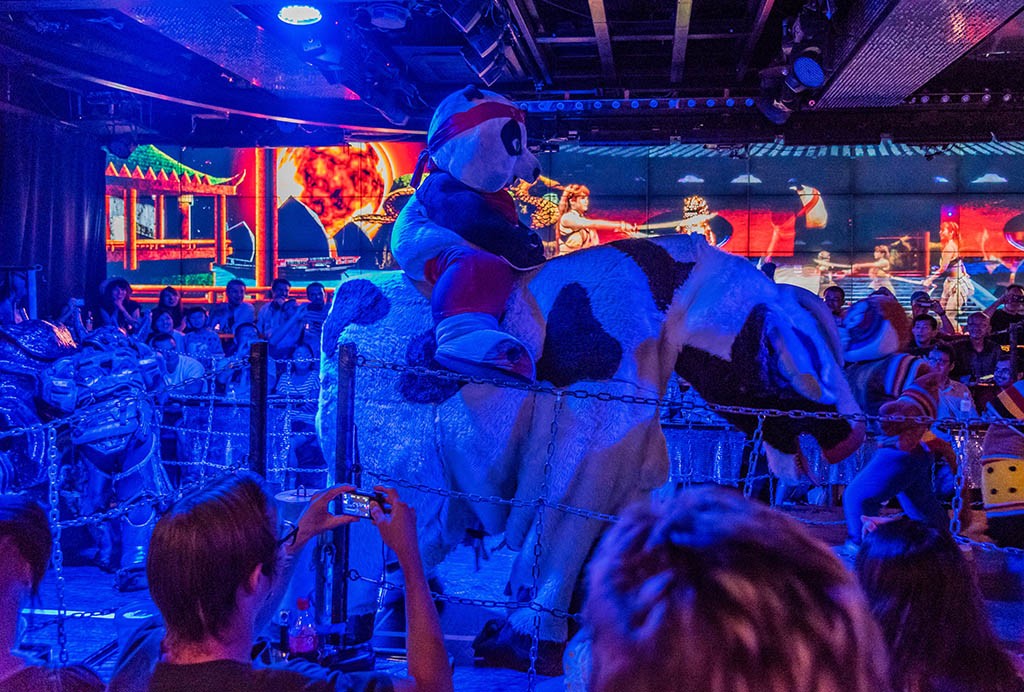
It all together makes absolutely no sense, there’s no story between the fights and dances and more fights. It’s the most absurd and weirdest show I’ve ever attended.
Last 20 minutes I was mostly focused to facial expressions of the couple that was sitting opposite to us. The guy was mostly looking just straight in front and was waiting for the torture to finish, while you could read the total confusion from lady’s face. 🙂
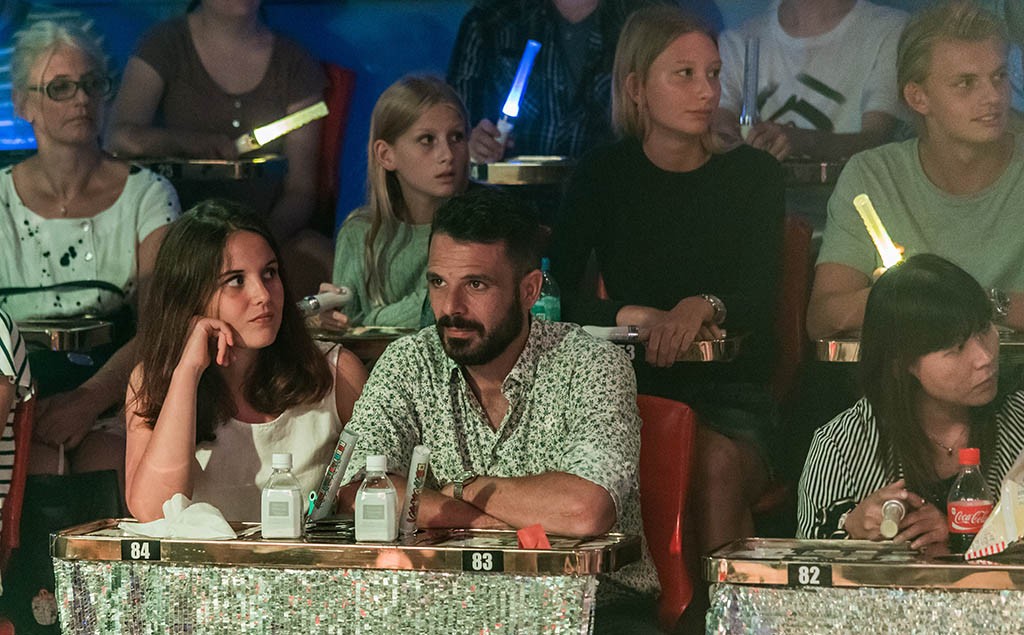
Yep, absolute madness. But in case that you are visiting Tokyo it’s a must see thing. It’s such trash that it’s hard to explain, yet one of a kind show that you should see. 🙂
We strolled a bit through Shinjuku by night and enjoyed the Neon lights and I’ve noticed one of those well known night riders.

Well, I guess he had a good ride that night since we lost him quite quickly. 🙂
Ueno Zoo
Next morning we headed towards Ueno.
Ueno is known as cultural district where the huge Ueno Park, Ueno Zoo and couple of big museums and temples are located. It was the hottest day in Tokyo and it was unbearable.
In front on the parking lot there was some kind of festival where people were supposed to celebrate, but majority of them were hiding in shadows and tried to get some air.
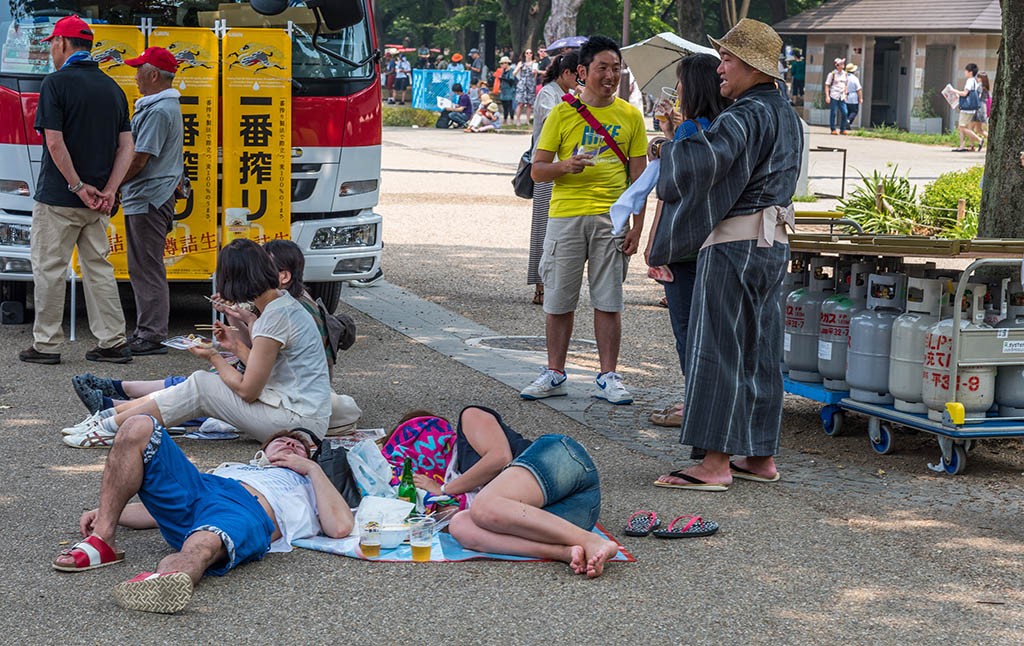
We strolled a bit around the park, then had to hide in a nearby coffee shop to cool down a bit, then we went for a walk through the zoo. It is the oldest Japanese zoo that was open back in 1882, but it is one of the saddest zoos I’ve been to. There were some interesting animlas like this Shoebil Stork, but majority of animals are in very small boxes and they don’t really look happy.

After the zoo we were on the way to Akihabara, but when we entered the subway on Nezu station I got confused with this underground library. It seems (according to information available online) that on this spot you can pick a book and return it or return some other time. The library is completely unattended. In country like Japan, this is easily done since there are almost no thefts.
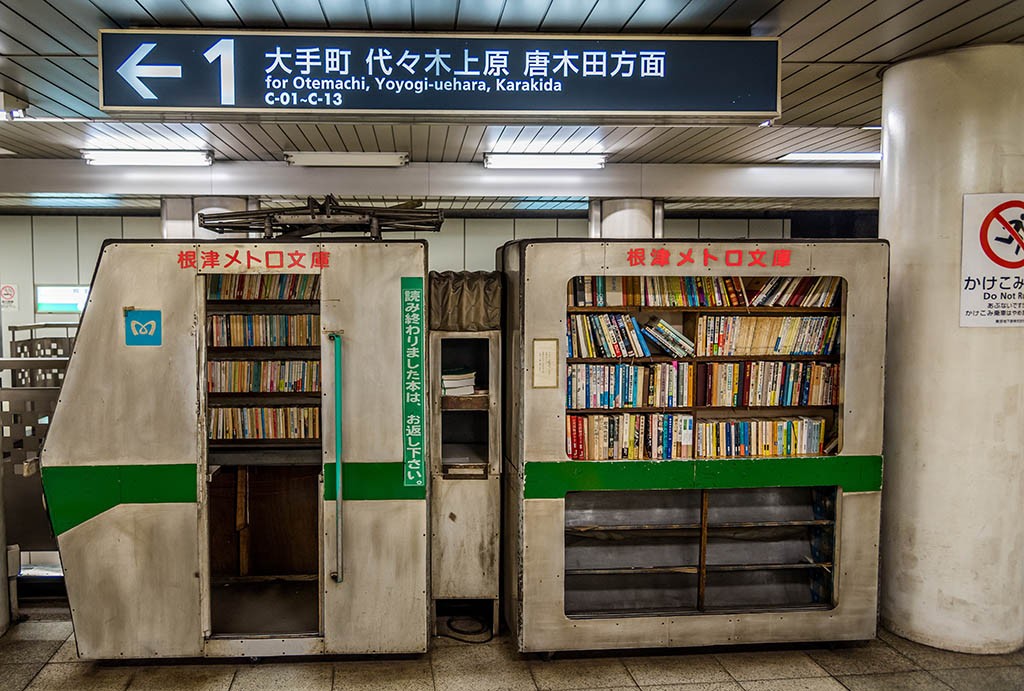
Akihabara
Akihabara is well known as Electric Town – district where video games, anime, manga and electronic goods can be purchased. At the time of our visit there was some presentation of a new gaming console and some new games. For that purpose whole 8 tracks avenue was closed and thousands of people were wondering around.
Many of these shops had girls dressed in some of the dresses and inviting potential buyers in the shop.
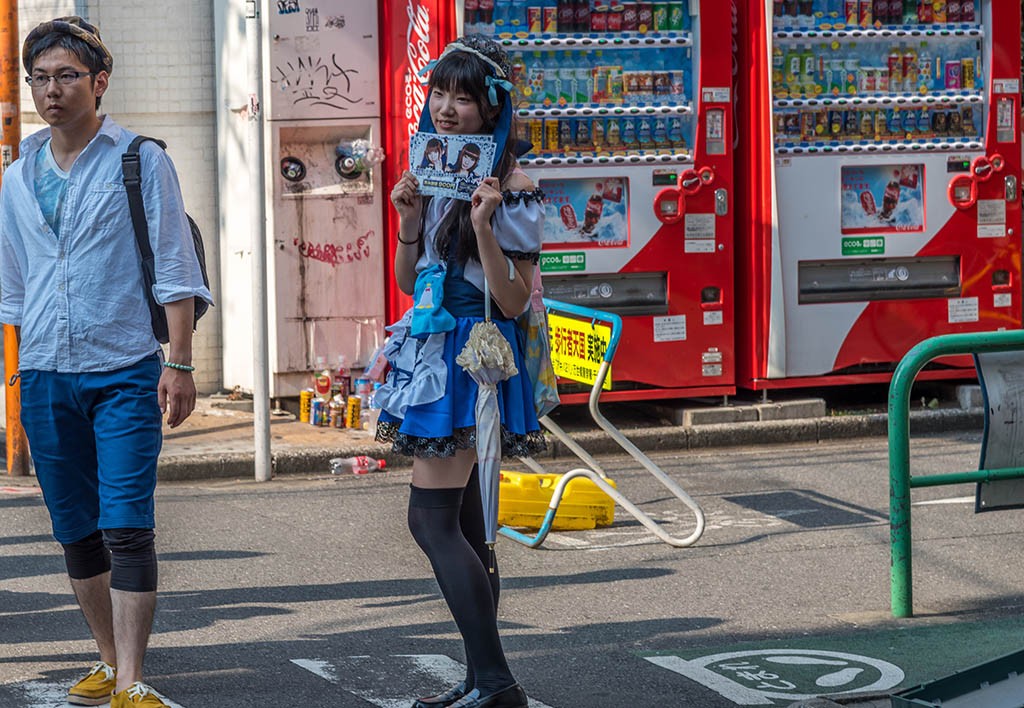
We entered some of them and among them one that sells figures from almost every cartoon, movie or anime. Thousands of figures from tiny to half meter big pink cat with a ribbon on her head. 🙂
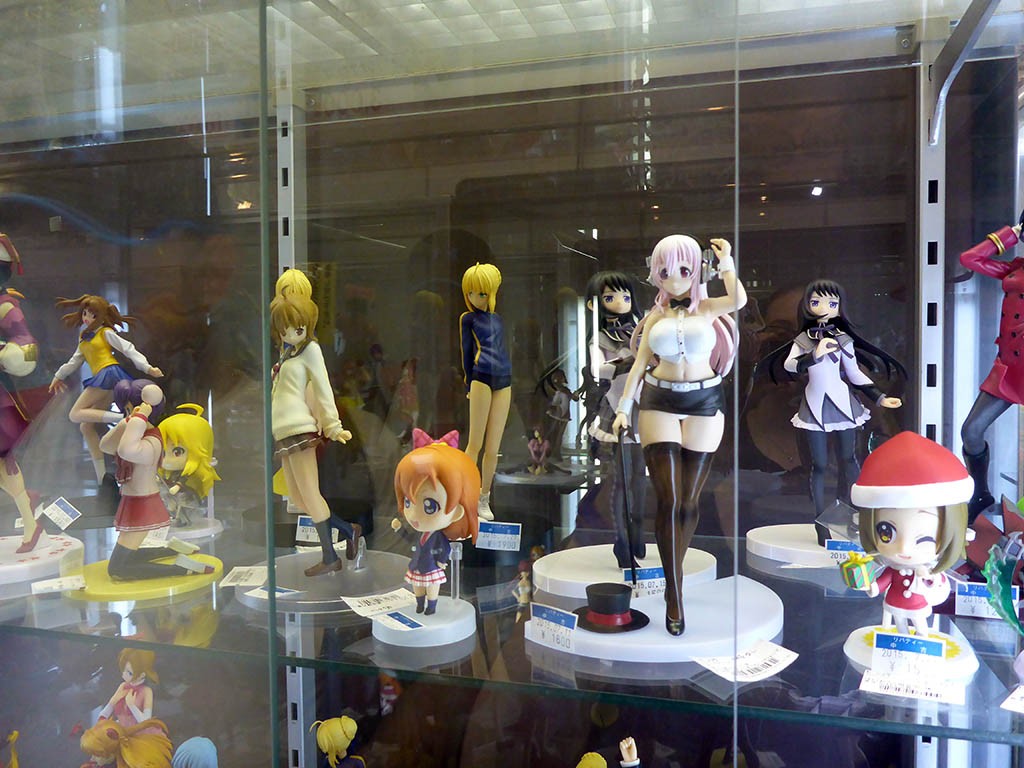
On our last day we wondered around our neighborhood in Katsushika since we were recovering from that Fuji descent. 🙂
Katsushika was a great surprise, simple, small district on the north east side of the city but I’ll write about it in separate post.
After 4 days in Tokyo my conclusion can be wrong since we’ve seen only bits of it, but it’s one of the cleanest cities I’ve ever been. In 4 days we’ve seen 1 (ONE) paper on the ground, and one dried leaf. With population of 35 million people I’d say it is quite impressive.
Common belief that trains are always on time is more or less true, but we experienced metro that was two minutes late! 🙂 I guess they count that in total time from start to end train should be on schedule, but as you can see this one was late.
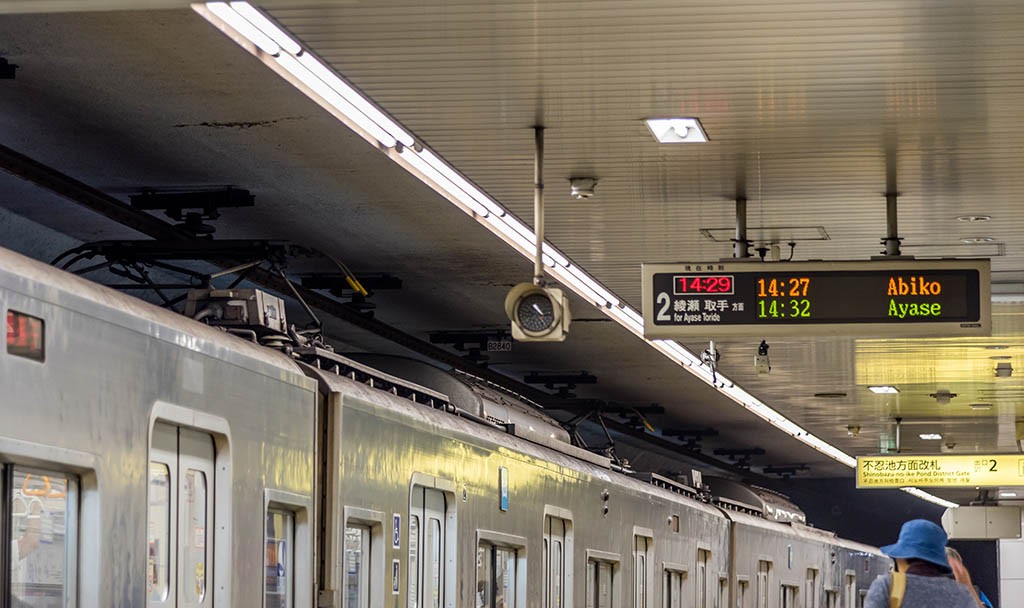
Proof that Japanese are people similar to us all and that they will ignore rules if those make no sense can be visible in every metro. Even though there is a big sign that in that particular car places are for people with heart problems and that all phones should be off, no one bothered with it.
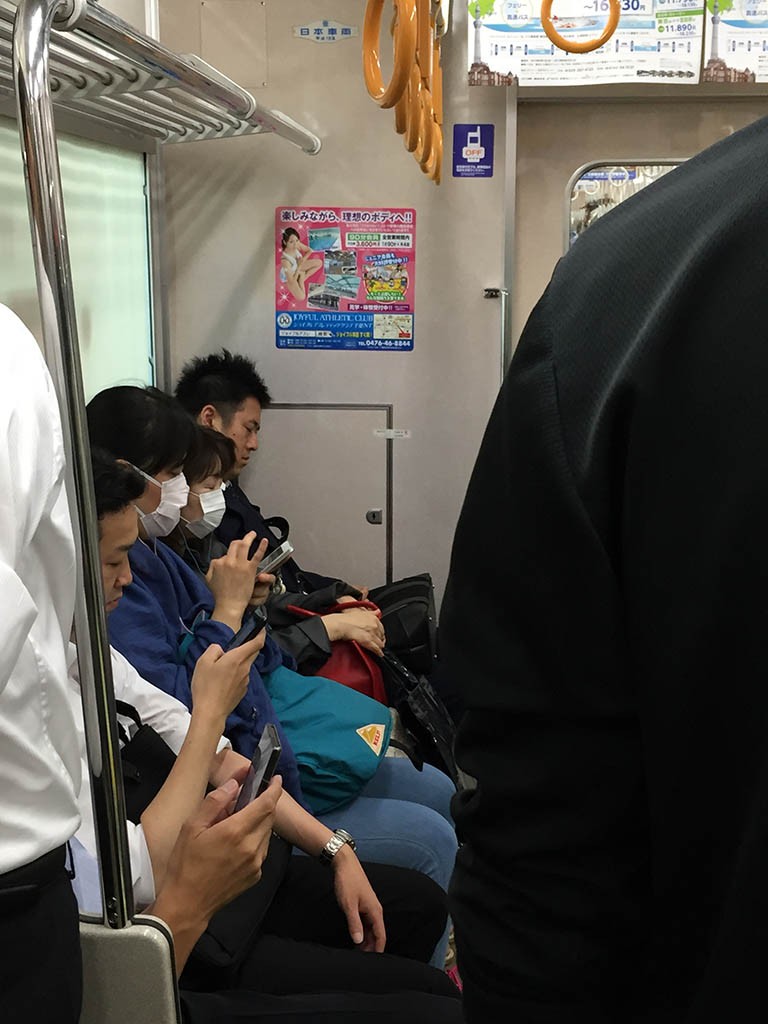
And if you are a lady, you should pay attention to up-skirting. Apparently one of big problems in Japan are “chikans”. Chickans are perverts who are groping ladies in crowded trains or take photographs of their underware. Problem is so big that there are special train wagons only for ladies, and you can see warning signs on major underground stations.
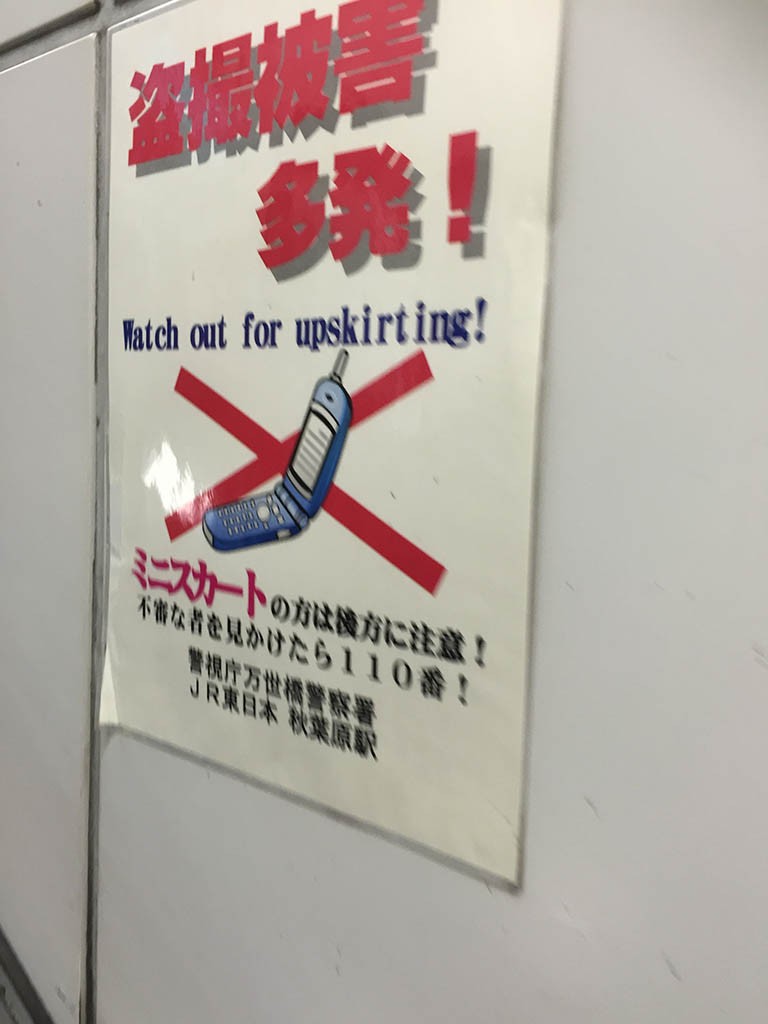
All in all Tokyo is an amazing place, something totally different from what I’ve seen so far, and I’d really love to spend more time in Tokyo and Japan in general. I doubt that I’d like the working atmosphere where people work 24/7 and sleep in every possible position in trains, metros and even outside in the parks.
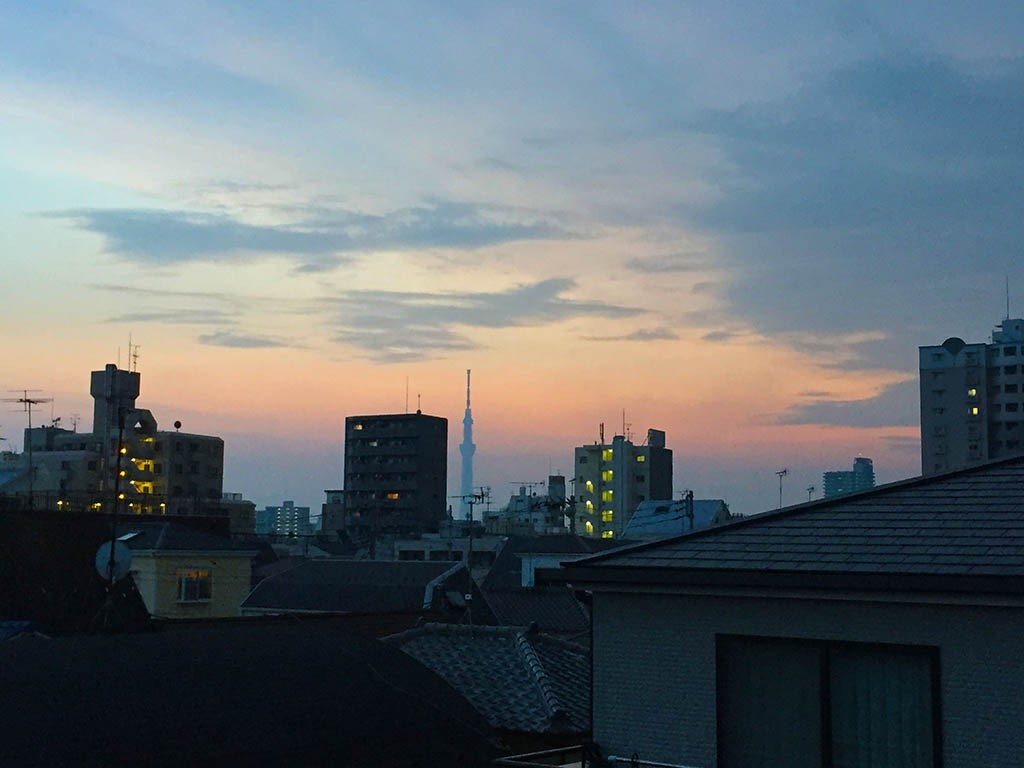
And with the view we had every evening before going to bed I’m finishing this post.
It was not the easiest one, too many things happened in very short time and everything was awesome. I’ll try to make a couple of shorter ones sooner. 🙂
Till then,
Kisses,
Balky
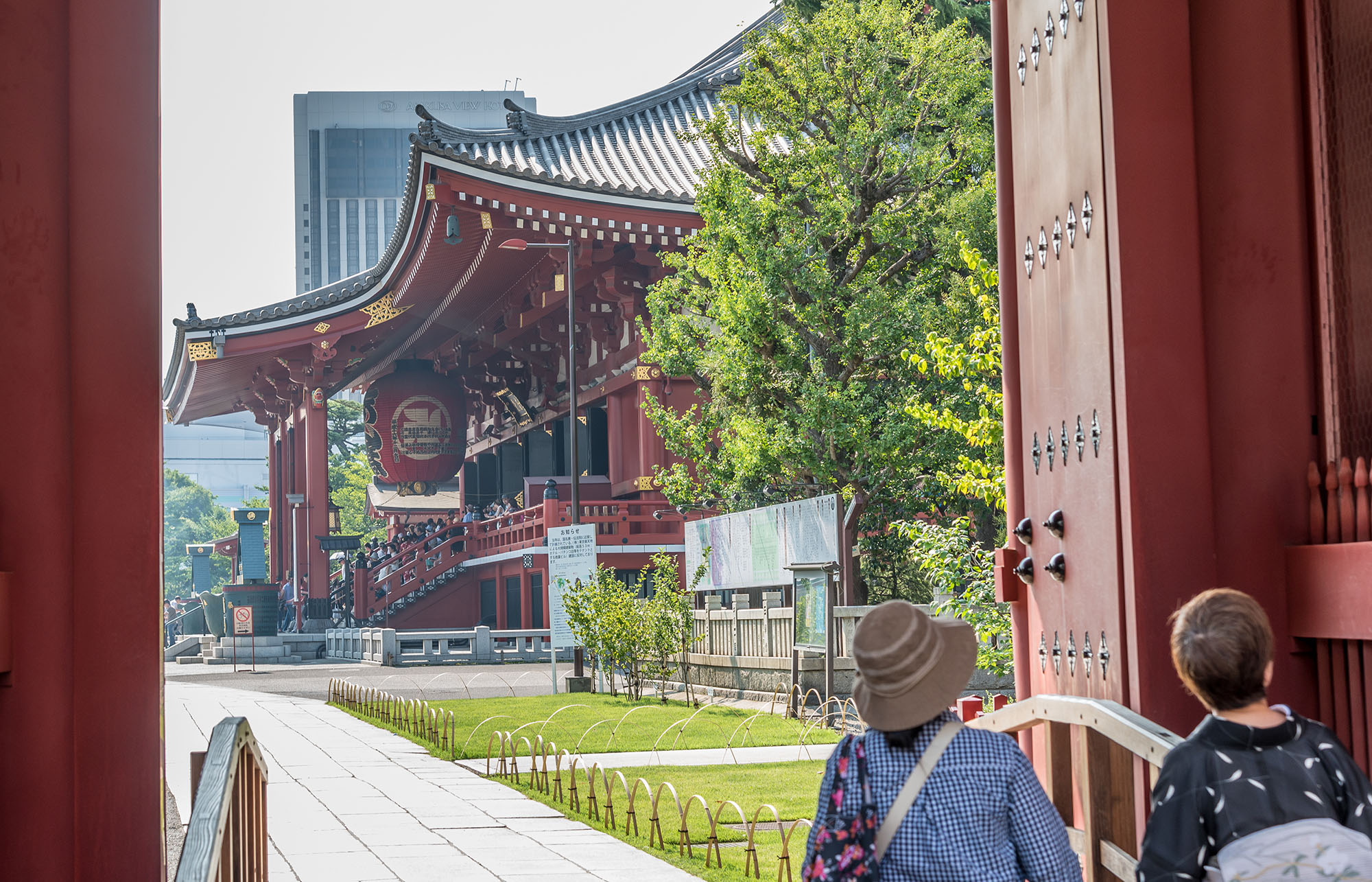
You must be logged in to post a comment.